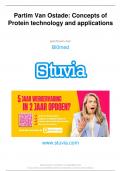Partim Van Ostade: Concepts of
Protein technology and applications
geschreven door
Bi0med
www.stuvia.com
Gedownload door: InnePatteet | inne.patteet@hotmail.be
Dit document is auteursrechtelijk beschermd, het verspreiden van dit document is strafbaar.
, Stuvia - Koop en Verkoop de Beste Samenvattingen
Concepts of Protein Technology & Applications:
v. Ostade
- Theory 30 hrs. (15/20) & Practicum 25 hrs. (5/20)
- Demonstration of mass spectrometer in December
- Article about proteomics: read and understand -> bring it to the exam!
- ‘Refresh’ lesson?
- Examination: Written ± 5 questions:
o 2 questions (Prof. Boonen), may include an exercise (15 points)
o 2 questions (Prof. Van Ostade), may include an exercise (15 points)
o 1-2 questions: article (10 points)
- Not successful in part prof. Maudsley or Van Ostade (< 8/20) -> no credits!
Introduction
Definition Proteomics:
Determination of the complete set of proteins that is present in a system, under specific
circumstances
System: Circumstances:
- Protein complex - Treatment (e.g. chemo, hormones..)
- Subcellular compartment - Time after treatment
- Cell - Condition of the cell (age, normal, infected, tumor…)
- Tissue - …
- Organism
Why proteomics?
Various reasons:
1. Compared to genomics, proteomics is ‘the real thing’
Proteins are the work horses from the cell and perform the work. The genes contain the information
but the real work happens because of the proteins. And these can change a lot: they can be
modified, they can interact… They are diverse in their function which gives information on the state
of the cell. Suppose you have a motorcycle and you know all these parts = genomics. But these parts
assemble and interact with each other = proteomics.
Genome sequencing:
- Humans have +- 20.000-40.000 genes, yeast 6000, plant 26.000, Drosophila 13.000
- Its still difficult to predict genes: verification of gene product by proteomic analysis =
necessary
Proteogenomics
2. mRNA vs. protein profiling
mRNA sequencing gives information on expression levels of mRNA. BUT there is not always a direct
correlation between the amount of expressed mRNA and the abundancy of that particular protein.
There are situations where a low level of mRNA gives a high abundancy of proteins or vice versa.
Gedownload door: InnePatteet | inne.patteet@hotmail.be
Dit document is auteursrechtelijk beschermd, het verspreiden van dit document is strafbaar.
, Stuvia - Koop en Verkoop de Beste Samenvattingen
There is no diagonal line so no direct
correlation between mRNA and protein
profiling.
3. More (6-8) proteins per gene
3.1 Posttranslational modifications (PTMs)
A protein can be chemically modified after it is synthesized. This can be done in several ways:
glycosylation, phosphorylation, methylation, acetylation, acylation, ubiquitination, …
3.2 Alternative splicing -> isoforms
A produced mRNA can be spliced or alternative spliced which
give other proteins resulting from the same gene. α-1-
antitrypsin can be spliced into 22 different isoforms.
4. Protein interaction networks
= Higher order of complexity without drastic increase of number of components.
Genes normally don’t interact with each other. Proteins interact with each other all the time. At least
78% of yeast proteins is involved in complex. Most cellular processes are regulated by protein
complexes instead of individual proteins. You can study a protein and determine the expression level
but as long as you study it individually, the results won’t be very valuable.
Functional proteomics: definition of protein as an element in an interaction network (‘contextual
function’), rather than ascribing it to one function.
5. Cellular localization
Depending on the biological state of the cell, a protein can be localised in one or different cellular
locations (nucleus, cytosol, plasma membrane mitochondria, ER…).
Different binding partners in different locations -> One protein can have several functions, depending
on the localisation in the cell.
Gedownload door: InnePatteet | inne.patteet@hotmail.be
Dit document is auteursrechtelijk beschermd, het verspreiden van dit document is strafbaar.
, Stuvia - Koop en Verkoop de Beste Samenvattingen
All these features cannot be predicted by genome sequencing proteomics.
Proteomics as a part of systems biology
Proteins can change all the time. We must perform several studies to know the states of this protein,
and integrate the results of these studies to have a realistic idea of the behaviour of the proteome in
the cell. In order to understand the dynamic complexity of an organism, an integrated image of all
aspects of proteins needs to be developed:
1 First off, we can study mRNA profiles and protein profiles and investigate how these change over
time, e.g. during development or changing conditions (e.g. pathological). And see how the abundancy
of the mRNA or protein change over time.
Secondly, another possibility is to study the state and properties of the proteins over time:
- Posttranslational modifications
- Cellular localization
2 - Binding of ‘metabolomic’ ligands: e.g. haem ring, metal ions, glucose, ATP, ADP, GTP,GDP…
- Alternative splicing forms
- Proteolytic degradation: synthesis, localization and activity of proteases are regulating
factors
- Oligomeric state and contribution in complexes
- Structure, conformation and allosteric mechanisms
3 Third, we can study all protein-protein interactions in space and time in one cell.
together with genomic and metabolomic data (in space and time) we can try to form system
biology
Together: ‘shotgun’ proteom
The different faces of proteomics You identify many proteins
1. Proteomics sensu strictu quantify them at the same ti
Large scale identification and characterization of proteins, inclusive You know which are present
their posttranslational modifications: list of which proteins are present you can compare e.g. a hea
and a cancer cell: which prot
2. Differential proteomics
are upregulated, compare PTM
Large scale comparison of protein expression levels: most used
3. Cell-mapping proteomics
Protein-protein interaction studies
Identification of proteins: principle
Gedownload door: InnePatteet | inne.patteet@hotmail.be
Dit document is auteursrechtelijk beschermd, het verspreiden van dit document is strafbaar.




